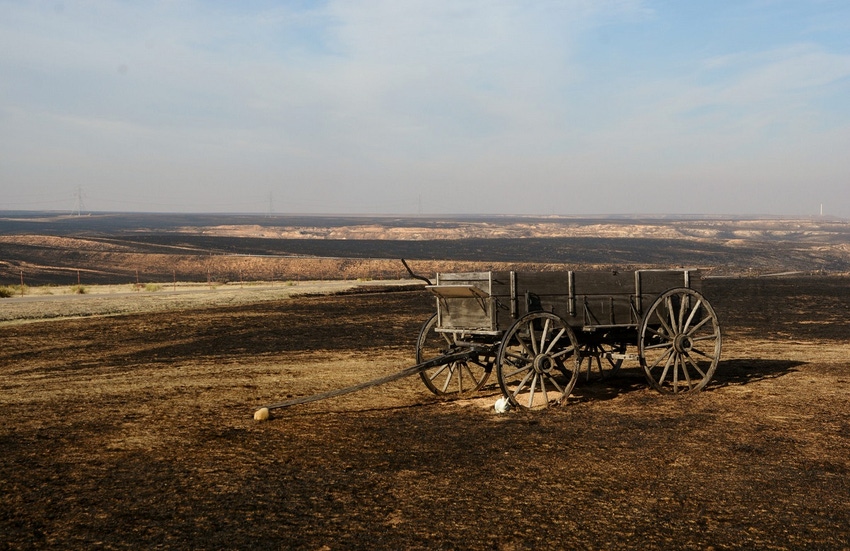March 14, 2017

Texas farmers and ranchers affected by last week’s wildfires should contact their USDA Farm Service Agency (FSA) office to obtain information about disaster assistance programs to aid recovery efforts.
Several programs enacted in the Agriculture Act of 2014 will aid some producers. The Natural Resource conservation Service (NRCS) also offers programs to aid in restoring grazing lands lost to the wildfires.
Erasmo (Eddie) Trevino, acting Texas State FSA Executive Director in College Station, says the agency can assist farmers who lost livestock, grazing land, fences or eligible trees, bushes and vines as a result of a natural disaster. Several safety net programs are available, including: the Livestock Indemnity Program, the Emergency Assistance for Livestock, Honeybees, and Farm-Raised Fish Program, and the Tree Assistance Program. Detailed information on all of these disaster assistance programs can be found online at www.fsa.usda.gov/disaster.
CONSERVATION PROGRAM
Also the FSA Emergency Conservation Program provides funding and technical assistance for farmers and ranchers to rehabilitate farmland damaged by natural disasters. Producers located in counties that receive a primary or contiguous disaster designation are eligible for low-interest emergency loans to help them recover from production and physical losses. Compensation is also available to producers who purchased coverage through the Noninsured Crop Disaster Assistance Program, which protects non-insurable crops (including native grass for grazing) against natural disasters that result in lower yields, crop losses or prevented planting.
“Recent wildfires have caused devastating losses for many farmers and ranchers in our state,” says Trevino. “Over the past several years, wildfires have increased in severity, intensity, and cost as the fire season has grown longer. Natural disasters such as wildfires are unavoidable, but USDA has strong safety-net programs to help producers get back on their feet.”
For more FSA disaster assistance program information, please contact your local USDA Service Center. To find your local USDA Service Center go to http://offices.usda.gov.
NRCS
The USDA-Natural Resources Conservation Service (NRCS) is urging landowners affected by the fires to contact the NRCS office at their local USDA Service Center.
The NRCS can provide land management advice, and in some cases, financial assistance, to install measures that reduce post-fire damage and aid in the rehabilitation process.
“NRCS in Texas is prepared to assist landowners with their efforts to address wind erosion that is continuing to occur due to drought and the effects from wildfires,” says Salvador Salinas, State Conservationist for the USDA-NRCS in Texas. “Loss of vegetation not only affects forages for livestock and wildlife habitat, but it can lead to increased soil loss due to erosion by wind and water.”
NRCS professional resource conservationists can inform landowners about practices such as grazing deferment, cross fencing, reseeding and water development that are effective post-fire strategies to help reduce erosion.
“We can also provide assistance that will enable landowners to accelerate the health and vigor of affected rangeland,” says Salinas. “In all but the most extreme cases, plants are still alive below the surface of the soil and will recover with proper management.”
CONSERVATION PLAN
He recommends that landowners and managers consult local NRCS district conservationists to develop a conservation plan, which can be an effective strategy for pasture and rangeland recovery. Financial assistance may be available through the Environmental Quality Incentives Program (EQIP) for range deferment of all livestock grazing throughout the growing season, plant health concerns, and cross fencing assistance.
To apply, landowners must visit the local NRCS office to fill out an application. Applications will be ranked, and those approved for funding will be offered an EQIP contract. An additional $3.4 million has been requested to help address resource concerns related to wildfires, but that amount has not yet been approved.
For further assistance in evaluating land and planning practices to address concerns following a wildfire, contact your local NRCS or Soil and Water Conservation District. For more information and listings for additional USDA Service Centers visit the Texas NRCS website at www.tx.nrcs.usda.gov
You May Also Like




